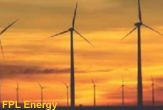Powerful New Map: Where the Wind Blows

A new map highlights spots where there is enough wind to provide electricity to the whole world - and then some.
In putting together a global and U.S. map, researchers found wind power could provide 40 times more electricity than is needed worldwide.
Scientists gathered wind speed data from about 8,000 locations on the planet - 7,500 surface stations and 500 balloon-launch stations. They measured the wind speeds 260 feet (80 meters) above the ground surface, which is the height of a modern wind turbine's hub.
At the surface stations, they could only measure wind speeds at 33 feet (10 meters), but they developed a method to figure out what that meant for winds at the more important height.
They found that 13 percent of the 8,000 spots were capable of averaging Class 3 wind speeds throughout the course of the year. Class 3 winds are greater than 15.4 mph (6.9 meters per second), which is considered strong enough to be economically feasible.
"What this means is quite amazing," Cristina Archer, of Stanford University and co-author of this study, told LiveScience. "If you pick 10 random locations on the planet, that means one, or even two, of these are suitable for wind power generation."
If harnessed, these sites with Class 3 and higher wind speeds could provide 72 terawatts of electricity - enough to run 1.2 trillion 60-watt light bulbs or 48 billion toasters.
"We would be fools not to use it," Archer said.
About 2.5 million wind turbines -- together capturing about 20 percent of what's available based on the new maps -- would be needed to produce all the world's electrical needs, Archer said.
The wind doesn't blow constantly, however, and it cannot be adjusted to follow electricity demand. Archer hopes that one day the bulk of our electricity will come from green energies, like wind power, with the gaps being filled by more reliable and traditional energies, like the burning of fossil fuels.
This new map is seen as a step in that direction. It demonstrates where power companies could get the best bang for their buck in wind farms - mostly near coastlines.
"I wouldn't necessarily recommend installing a wind farm based only on our map. But it's definitely a starting point," Archer said.
The results, and additional maps, are detailed in the May issue of The Journal of Geophysical Research-Atmospheres.
Related Stories
- Power of the Future: 10 Ways to Run the 21st Century
- Windmills to Change Local and Global Climates
- Cousteau Grandson Backs Ocean Windmill Farm
- Several Massachusetts Communities Eye Wind Power
Get the world’s most fascinating discoveries delivered straight to your inbox.


